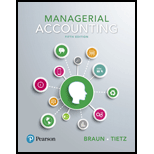
Classify sustainable activities’ effect on
The Plastic Lumber Company, Inc., (PLC) is a manufacturer that takes in post-consumer plastics (i.e., empty milk jugs) and recycles those plastics into a “plastic lumber” that can be used to build furniture, decking, and a variety of other items. Because Plastic Lumber has a strong focus on sustainability, the company managers try, whenever possible, to use recycled materials and to invest in sustainable projects.
Last year, the company engaged in several sustainable practices that have an impact on its cash flows. For each of the transactions listed below, indicate whether the transaction would have affected the operating, investing, or financing cash flows of the company. Additionally, indicate whether each transaction would have increased (+) or decreased (−) cash.
Transactions:
- 1. New production equipment that is 60% more energy efficient than the old equipment was purchased for cash.
- 2. When the plastic wood is cut into lengths needed to build park benches, the end pieces cut off are scrap. PLC sold this cutting scrap to another recycler.
- 3. Engineers at PLC performed research into a new process that injects tiny air bubbles into the plastic to reduce the usage of raw materials (plastics) and to reduce the weight of the finished products.
- 4. Throughout the year, PLC participated in several trade shows that featured green products for use by parks and recreation facilities. For each trade show, PLC incurred cash expenses for transportation, registration, meals and lodging, and booth setup.
- 5. A Toyota Prius hybrid automobile was purchased for use by the CEO of PLC. PLC paid cash.
- 6. PLC issues long-term bonds during the year to help finance growth.
- 7. PLC became a minority partner in a solar-panel electricity generation project by investing $1 million in cash in the project.
- 8. A fleet of plug-in electric cars was purchased for sales staff. PLC paid cash.
- 9. A wind-turbine was built to power part of PLC’s operations. PLC paid cash.
- 10. PLC installed a “living roof” on its manufacturing facility. This roof is made mostly from sedum runoff and doubles the expected life of the roof over that of a conventional roof. The plants also reduce heating and cooling needs by providing an extra layer of insulation Additionally, the plants absorb carbon dioxide to help reduce greenhouse gases. The living roof was paid for with cash.
Want to see the full answer?
Check out a sample textbook solution
Chapter 13 Solutions
Managerial Accounting, Student Value Edition (5th Edition)
- QS 15-18 (Algo) Computing and recording over- or underapplied overhead LO P4 A company applies overhead at a rate of 170% of direct labor cost. Actual overhead cost for the current period is $1,081,900, and direct labor cost is $627,000. 1. Compute the under- or overapplied overhead. 2. Prepare the journal entry to close over- or underapplied overhead to Cost of Goods Sold. Complete this question by entering your answers in the tabs below. Required 1 Required 2 Compute the under- or overapplied overhead.arrow_forwardQuestion 6 During 2019, Bitsincoins Corporation had EBIT of $100,000, a change in net fixed assets of $400,000, an increase in net current assets of $100,000, an increase in spontaneous current liabilities of $400,000, a depreciation expense of $50,000, and a tax rate of 30%. Based on this information, what is Bitsincoin's free cash flow? (3 marks)arrow_forwardQuestion 4 Waterfront Inc. wishes to borrow on a short-term basis without reducing its current ratio below 1.25. At present its current assets and current liabilities are $1,600 and $1,000 respectively. How much can Waterfront Inc. borrow? (5 marks)arrow_forward
 Intermediate Financial Management (MindTap Course...FinanceISBN:9781337395083Author:Eugene F. Brigham, Phillip R. DavesPublisher:Cengage LearningPrinciples of Accounting Volume 2AccountingISBN:9781947172609Author:OpenStaxPublisher:OpenStax College
Intermediate Financial Management (MindTap Course...FinanceISBN:9781337395083Author:Eugene F. Brigham, Phillip R. DavesPublisher:Cengage LearningPrinciples of Accounting Volume 2AccountingISBN:9781947172609Author:OpenStaxPublisher:OpenStax College Cornerstones of Cost Management (Cornerstones Ser...AccountingISBN:9781305970663Author:Don R. Hansen, Maryanne M. MowenPublisher:Cengage Learning
Cornerstones of Cost Management (Cornerstones Ser...AccountingISBN:9781305970663Author:Don R. Hansen, Maryanne M. MowenPublisher:Cengage Learning Managerial AccountingAccountingISBN:9781337912020Author:Carl Warren, Ph.d. Cma William B. TaylerPublisher:South-Western College Pub
Managerial AccountingAccountingISBN:9781337912020Author:Carl Warren, Ph.d. Cma William B. TaylerPublisher:South-Western College Pub





